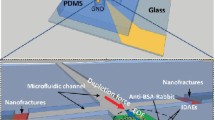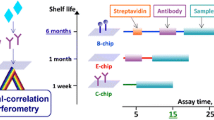Abstract
Miniaturization of the sandwich enzyme-based immunosensor has several advantages but could result in lower signal strength due to lower enzyme loading. Hence, technologies for amplification of the signal are needed. Signal amplification in a field effect-based electrochemical immunosensor utilizing chip-based ELISA is presented in this work. First, the molarities of phosphate buffer saline (PBS) and concentrations of KCl as ionic strength adjuster were optimized to maximize the GOx glucose-based enzymatic reactions in a beaker for signal amplification measured by change in the voltage shift with an EIS device (using 20 μl of solution) and validated with a commercial pH meter (using 3 ml of solution). The PBS molarity of 100 μM with 25 mM KCl provided the maximum voltage shift. These optimized buffer conditions were further verified for GOx immobilized on silicon chips, and similar trends with decreased PBS molarity were obtained; however, the voltage shift values obtained on chip reaction were lower as compared to the reactions occurring in the beaker. The decreased voltage shift with immobilized enzyme on chip could be attributed to the increased Km (Michaelis–Menten constant) values in the immobilized GOx. Finally, a more than sixfold signal enhancement (from 8 to 47 mV) for the chip-based sandwich immunoassay was obtained by altering the PBS molarity from 10 to 100 μM with 25 mM KCl.





Similar content being viewed by others
References
Selvakumar, L. S., & Thakur, M. S. (2012). Dipstick based immunochemiluminescence biosensor for the analysis of vitamin B12 in energy drinks: a novel approach. Analytica Chimica Acta, 722, 107–113.
Nian, H., Wang, J., Wu, H., Lo, J.-G., Chiu, K.-H., Pounds, J. G., & Lin, Y. (2012). Electrochemical immunoassay of cotinine in serum based on nanoparticle probe and immunochromatographic strip. Analytica Chimica Acta, 713, 50–55.
Perrotta, P. R., Arévalo, F. J., Vettorazzi, N. R., Zón, M. A., & Fernández, H. (2012). Development of a very sensitive electrochemical magneto immunosensor for the direct determination of ochratoxin A in red wine. Sensors and Actuators B: Chemical, 162, 327–333.
Yang, H., Liang, W., He, N., Deng, Y., & Li, Z. (2015). Chemiluminescent labels released from long spacer arm-functionalized magnetic particles: a novel strategy for ultrasensitive and highly selective detection of pathogen infections. ACS Applied Materials & Interfaces, 7, 774–781.
Li, Z., Yang, H., He, N., Liang, W., Ma, C., Shah, M. A. A., Tang, Y., Li, S., Liu, H., Jiang, H., & Guo, Y. (2013). Solid-phase hybridization efficiency improvement on the magnetic nanoparticle surface by using dextran as molecular arms. Journal of Biomedical Nanotechnology, 9, 1945–1949.
Fitzgerald, J., Leonard, P., Danaher, M., & O’Kennedy, R. (2015). Rapid simultaneous detection of anti-protozoan drugs using a lateral-flow immunoassay format. Appl Biochem Biotechnol, 176, 387–398.
Szcs, J., Pretsch, E., & Gyurcsányi, R. E. (2009). Potentiometric enzyme immunoassay using miniaturized anion-selective electrodes for detection. Analyst, 134, 1601–1607.
Jung, H. S., Song, K. S., & Kim, T. (2007). Electrochemical immunosensing of GOx-labeled CRP antigen on capture antibody monolayer immobilized on calixcrown-5 SAMs. Bulletin of the Korean Chemical Society, 28, 1792–1796.
Singh, A., Park, S., & Yang, H. (2013). Glucose-oxidase label-based redox cycling for an incubation period-free electrochemical immunosensor. Analytical Chemistry, 85, 4863–4868.
Horak, J., Dincer, C., Bakirci, H., & Urban, G. (2014). Sensitive, rapid and quantitative detection of substance P in serum samples using an integrated microfluidic immunochip. Biosensors and Bioelectronics, 58, 186–192.
de Bellefontaine, C., Josse, F., Domurado, M., & Domurado, D. (1994). Immunoassay for native enzyme quantification in biological samples. Appl Biochem Biotechnol, 48, 117–123.
Selvanayagam, Z. E., Neuzil, P., Gopalakrishnakone, P., Sridhar, U., Singh, M., & Ho, L. C. (2002). An ISFET-based immunosensor for the detection of β-Bungarotoxin. Biosensors and Bioelectronics, 17, 821–826.
Kamahori, M., Ishige, Y., & Shimoda, M. (2008). Enzyme immunoassay using a reusable extended-gate field-effect-transistor sensor with a ferrocenylalkanethiol-modified gold electrode. Analytical Sciences, 24, 1073–1079.
Jang, H.-J., Ahn, J., Kim, M.-G., Shin, Y.-B., Jeun, M., Cho, W.-J., & Lee, K. H. (2015). Electrical signaling of enzyme-linked immunosorbent assays with an ion-sensitive field-effect transistor. Biosensors and Bioelectronics, 64, 318–323.
Elanchezhian, V. S., & Kandaswamy, M. (2009). A ferrocene-based multi-signaling sensor molecule functions as a molecular switch. Inorganic Chemistry Communications, 12, 161–165.
Qiu, J. D., Zhou, W. M., Guo, J., Wang, R., & Liang, R. P. (2009). Amperometric sensor based on ferrocene-modified multiwalled carbon nanotube nanocomposites as electron mediator for the determination of glucose. Anal Biochem, 385, 264–269.
Wu, Y., Zheng, J., Li, Z., Zhao, Y., & Zhang, Y. (2009). A novel reagentless amperometric immunosensor based on gold nanoparticles/TMB/Nafion-modified electrode. Biosensors & bioelectronics, 24, 1389–1393.
Parkash, O., Yean, C., & Shueb, R. (2014). Screen printed carbon electrode based electrochemical immunosensor for the detection of dengue NS1 antigen. Diagnostics, 4, 165–180.
Li, Y., Fang, L., Cheng, P., Deng, J., Jiang, L., Huang, H., & Zheng, J. (2013). An electrochemical immunosensor for sensitive detection of Escherichia coli O157:H7 using C60 based biocompatible platform and enzyme functionalized Pt nanochains tracing tag. Biosensors and Bioelectronics, 49, 485–491.
Ren, J., Tang, D., Su, B., Tang, J., & Chen, G. (2010). Glucose oxidase-doped magnetic silica nanostructures as labels for localized signal amplification of electrochemical immunosensors. Nanoscale, 2, 1244–1249.
Zhang, J., Pearce, M. C., Ting, B. P., & Ying, J. Y. (2011). Ultrasensitive electrochemical immunosensor employing glucose oxidase catalyzed deposition of gold nanoparticles for signal amplification. Biosensors and Bioelectronics, 27, 53–57.
Dastidar, S., Agarwal, A., Kumar, N., Bal, V., & Panda, S. (2015). Sensitivity enhancement of electrolyte-insulator-semiconductor sensors using mesotextured and nanotextured dielectric surfaces. Sensors Journal IEEE, 15, 2039–2045.
Kumar, N., Kumar, J., & Panda, S. (2015). Sensitivity enhancement mechanisms in textured dielectric based electrolyte-insulator-semiconductor (EIS) sensors. ECS Journal of Solid State Science and Technology, 4, N18–N23.
Jang, H.-J., & Cho, W.-J. (2012). Fabrication of high-performance fully depleted silicon-on-insulator based dual-gate ion-sensitive field-effect transistor beyond the Nernstian limit. Applied Physics Letters, 100, 073701.
Bae, T.-E., Jang, H.-J., Lee, S.-W., & Cho, W.-J. (2013). Enhanced sensing properties by dual-gate ion-sensitive field-effect transistor using the solution-processed Al2O3 sensing membranes. Japanese Journal of Applied Physics, 52, 06GK03.
Schoning, M. J., & Poghossian, A. (2002). Recent advances in biologically sensitive field-effect transistors (BioFETs). The Analyst, 127, 1137–1151.
Das Neves, L., & Vitolo, M. (2007). Use of glucose oxidase in a membrane reactor for gluconic acid production. Appl Biochem Biotechnol, 137–140, 161–170.
Good, N. E., Winget, G. D., Winter, W., Connolly, T. N., Izawa, S., & Singh, R. M. M. (1966). Hydrogen ion buffers for biological research. Biochemistry, 5, 467–477.
Stoll, V. S., & Blanchard, J. S. (2009). Methods in enzymology, vol. 463. In R. B. Richard, P. D. Murray (Eds.), Bufferes: principles and practice (pp. 43–56). Academic Press.
Schöning, M. J., Arzdorf, M., Mulchandani, P., Chen, W., & Mulchandani, A. (2003). Towards a capacitive enzyme sensor for direct determination of organophosphorus pesticides: fundamental studies and aspects of development. Sensors, 3, 119–127.
Preetha, R., Rani, K., Veeramani, M. S. S., Fernandez, R. E., Vemulachedu, H., Sugan, M., Bhattacharya, E., & Chadha, A. (2011). Potentiometric estimation of blood analytes - triglycerides and urea: comparison with clinical data and estimation of urea in milk using an electrolyte-insulator-semiconductor-capacitor (EISCAP). Sensors and Actuators B: Chemical, 160, 1439–1443.
Senillou, A., Jaffrezic-Renault, N., Martelet, C., & Cosnier, S. (1999). A miniaturized urea sensor based on the integration of both ammonium based urea enzyme field effect transistor and a reference field effect transistor in a single chip. Talanta, 50, 219–226.
Kumar, N., Kumar, J., & Panda, S. (2015). Low temperature annealed amorphous indium gallium zinc oxide (a-IGZO) as a pH sensitive layer for applications in field effect based sensors. AIP Advances, 5, 067123.
Kumar, S., Ch, R., Rath, D., & Panda, S. (2011). Densities and orientations of antibodies on nano-textured silicon surfaces. Materials Science and Engineering: C, 31, 370–376.
Good, N. E., & Izawa, S. (1972). Methods in enzymology, vol. 24. In A. San Pietro (Ed.), Hydrogen ion buffers (pp. 53–68). Academic Press.
Bright, H. J., & Appleby, M. (1969). The pH dependence of the individual steps in the glucose oxidase reaction. Journal of Biological Chemistry, 244, 3625–3634.
Tomotani, E., das Neves, L., & Vitolo, M. (2005). Twenty-sixth symposium on biotechnology for fuels and chemicals, vol. 121-124. In B. Davison, B. Evans, M. Finkelstein, J. McMillan (Eds.), Oxidation of glucose to gluconic acid by glucose oxidase in a membrane bioreactor (pp. 149–162). Humana Press.
Hoxsey, J. A. (2013). Mineral-releasing compost and method of using the same for soil remediation. US Patent, Appl. No. 13/817,128, Pub. No. US 2013/0233036A1.
Chen, R. K. (1992). Method of manufacturing soybean curd, US Patent, Appl. No. US 07/688,013, Pub. No. US5087465A.
Kumar, S., & Panda, S. (2012). Correlation of kinetics and conformations of free and immobilized enzymes on non- and nanotextured silicon biosensor surfaces. Bio Nano Sci., 2, 171–178.
Kojima, K., Hiratsuka, A., Suzuki, H., Yano, K., Ikebukuro, K., & Karube, I. (2003). Electrochemical protein chip with arrayed immunosensors with antibodies immobilized in a plasma-polymerized film. Analytical Chemistry, 75, 1116–1122.
Acknowledgment
The authors gratefully acknowledge the financial support of the DST Science and Engineering Research Board, India (Grant No. SB/S3/CE/055/2013).
Author information
Authors and Affiliations
Corresponding author
Additional information
Satyendra Kumar and Narendra Kumar contributed equally to this work.
Rights and permissions
About this article
Cite this article
Kumar, S., Kumar, N. & Panda, S. Signal Amplification in Field Effect-Based Sandwich Enzyme-Linked Immunosensing by Tuned Buffer Concentration with Ionic Strength Adjuster. Appl Biochem Biotechnol 179, 168–178 (2016). https://doi.org/10.1007/s12010-016-1986-y
Received:
Accepted:
Published:
Issue Date:
DOI: https://doi.org/10.1007/s12010-016-1986-y




